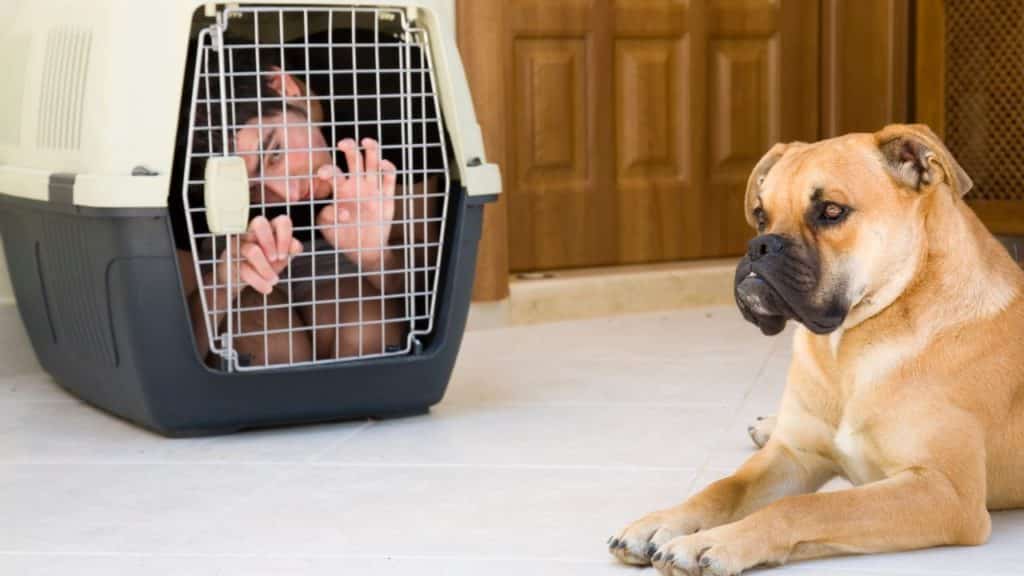
Dogs are social beings, but they need downtime to get away from the go-go-go. Dogs that don’t have a designated space for their own can become anxious or stressed when they’re cooped up in one room all day.
Kenneling your dog will not only give them some much-needed time alone, but it’ll also help teach them how to be calm and mindful in their kennel when you leave home. When should you start?
It depends on the age of your pup! Some dogs may never need to sleep in a kennel; others might require it early due to separation anxiety.
If your dog is destructive while you’re gone, it has trouble staying calm during certain situations like thunderstorms or fireworks.
Many of us feel the need to kennel our dogs when we go on vacation or leave them home alone.
- But is it cruel?
- At what age do you start?
- What are some alternatives?
- How to train a dog for a kennel?
Is it Cruel to Kennel Your Dog?
Dogs are social beings, but they need downtime when you’re away. Dogs that don’t have a designated space for their own can become anxious or stressed when left cooped up all day.
Kenneling your dog will not only give them some much-needed alone time, but it’ll also help teach them how to be calm and mindful in their kennel when you leave home.
It would help if you considered time while kenneling your dog, like up to 4 hours is the maximum limit for a dog. But beyond this limit, you will have to let your dog free. Otherwise, your dog may feel lonely and gets anxious.
In addition, you should also make sure that your pet is not staying in the kennel for a long time. Your dog will easily get stressed when it stays in a kennel for a long time without having a chance to do anything else. This is especially true if the kennel is not big enough.
So, when should you start?
It depends on the age of your pup! Some dogs may never need to sleep in a kennel; others may require it early due to separation anxiety.
If your dog is destructive while you’re gone, has trouble staying calm when you leave, or has separation anxiety at an early age, it might be time to invest in a kennel.
It would help to crate your dog when he is too young for training at around 12 weeks old. This way, they will get more used to being in the kennel instead of getting destructive.
There is a way to introduce your dog to their new home away from home that is positive reinforcement.
What are some alternatives to kenneling your dog?
When your dog is stressed, anxious, or destructive while you are gone, they need to be kenneled. Otherwise, the behavior will only get worse with time.
If your dog doesn’t have separation anxiety and has never been destructive before you leave them alone, then it may not always be necessary for them to sleep in a kennel.
You should try other alternatives that might work better for keeping your pup calm or working on their obedience training. These options include:
Securing the door so they can’t open it themselves – This may not be possible if there are kids around who are curious about what’s behind the locked door.
Putting a leash on your pup and tethering them in front of a window with a view – This will make your pup feel safe, although it might not be the ideal situation.
Keeping dog toys in the kennel with your pup during downtime or when they’re home alone can also work well until you’ve spent enough time working on obedience training.
Another solution is using a baby gate to confine your pup in one room of the house while they are alone. Just keep an eye out that the puppy doesn’t get too anxious while finding things to do.
Is It Cruel to Kennel, a Dog at Night?
Putting a dog in a kennel at night is the same as putting them in one during the day. It should be done both when awake and asleep, so your pup doesn’t have any time alone. If you have a puppy, the process should start when they are young to become a habit instead of a form of punishment or cruelty.
You’ve probably heard about people letting their dogs sleep in their bed with them every night. Well, this isn’t good for either party involved. First of all, you’re going to end up with broken sleep if your dog decides to get up at 4 AM and start licking your face!
In addition, it’s not practical to your pup into your bedroom for the next 10 years. This will also prevent them from developing good sleeping habits, which is bad for their health.
A better solution is to let your pup sleep in a kennel at night right beside your bed. It gives them the comfort of being nearby instead of isolated in another room or out in the garage.
You can even put some dog beds inside, so they have somewhere comfortable to lie down when you leave the door open all night long.
If your pup sleeps through the night without wandering around or barking, then it’s time to gradually increase kennel time limits until they are ready to be by themselves during the day too!
How to Kennel Train, Your Puppy in Your Home Outdoor Kennel
We humans have a lot to learn from dogs, especially how to have fun!
Even if you are stuck at home for the day, your pup can still play with toys and enjoy being around its owners. If an accident happens, put them in their kennel until they learn not to go inside anymore.
If your dog becomes destructive because of separation anxiety or boredom, then it may be time to purchase a kennel so that they don’t destroy anything else in your home.
The best part of kenneling your pup is that they will soon see it as their own haven instead of being a prison.
In fact, it can be a great tool for housebreaking new puppies and keeping them from having accidents inside the house while you are at work or school!
The most important thing to consider when kenneling an adult dog is their physical and mental health.
If they are elderly, have chronic pain, or are very anxious, it’s best not to kennel them for too long. You can use other training methods with them instead – like using a leash and baby gate – until you’ve worked on their obedience enough to release them from captivity.
When Is It Time To Get Out The Big Dogs Kennel
That depends on your pup! If there’s any doubt about whether or not your dog will be okay left alone without destroying the place, then don’t hesitate to put him in a powerful large that he cannot destroy his way out of it.
Having a big strong breed does not mean you don’t have to watch them like a hawk when they are in their kennel.
It’s important to give your dog lots of space when in the house, which is why it doesn’t make sense to leave them cooped up in their crate for too long.
Of course, if you release your doggy friend from captivity and they start tearing everything apart, then you know that they need more time inside until they get over their separation anxiety!
Kenneled Dog Chewing Something? That’s Normal Behavior
A dog being put in his kennel means that he must learn not to take himself out on other things instead.
If your big strong breed puppy or adult dog begins chewing something while kenneled, then it’s a good sign you didn’t give them enough time to play or exercise before you put them away.
The solution is to work your dog longer and make sure they get enough exercise before putting him in his kennel again, but this time for a little bit shorter of a time period.
Decreasing the length of time you leave your dog in their kennel before going into an obedience class will also help lower their stress levels.
It only makes sense that getting out the big dogs’ kennel before they are fully housetrained can be a defense mechanism to avoid having accidents inside the house after doing their thing outside!
